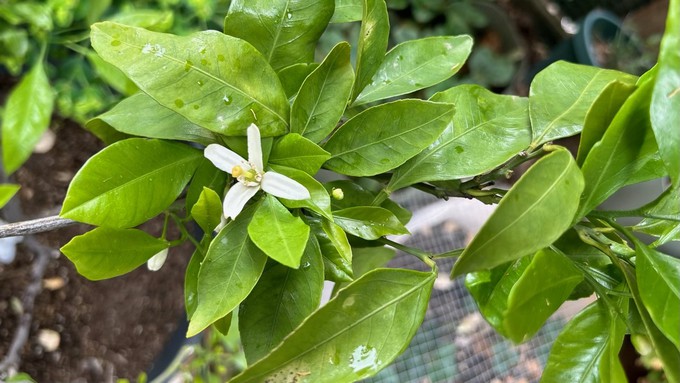
What to expect from our roller-coaster spring temperatures

Citrus trees like this little Satsuma mandarin are blooming later than normal because of our cooler spring. Kathy Morrison
Winter, summer, winter; what happened to our spring? Our temperatures seem to be ping-ponging back and forth, with afternoon highs fluctuating more than 30 degrees.
Call it whiplash weather, and it can do a number on fast-growing plants.
As temperatures rise, plants tend to grow more and faster. Cold spells slam on the brakes.
According to the National Weather Service, Sacramento hit a record high of 90 degrees on April 27. The high on Monday (May 1) was only 58 – 18 degrees below average for that date.
Tuesday also was chilly, topping out at 64 degrees. In addition, it was blustery with 30 mph winds and thunderstorms.
Some areas of Sacramento saw up to a half-inch of rain; downtown received only 0.06 of an inch
This spring already was weather challenged. A colder than normal April following a very wet March pushed back a lot of spring-blooming flowers as well as early fruit crops.
Orchard owners report that the Northern and Central California cherry crop is three to four weeks later than normal. Likewise for apricots and other early stone fruit.
Smell orange blossoms? Citrus trees bloomed on average four weeks later than normal. Many orange and lemon trees are just starting to open their flowers when they usually would be forming baby fruit now. Unless summer heat speeds up fruit development, those oranges and lemons will be late next winter and spring. (If temperatures rise too quickly, there may be a larger than normal fruit drop in June.)
As they form fruit, help your citrus trees with a dose of balanced fertilizer with equal amounts of nitrogen, phosphorus and potassium. A soup-can full of slow-release 8-8-8 fertilizer is enough for a full-size orange tree.
Young transplants – such as those baby tomatoes that just went in the ground – may be most susceptible to this whiplash weather. (After those winds on Tuesday, their little stems may be feeling whiplash, too.)
Keep seedlings comfortable by regulating soil temperature and moisture. Use mulch to maintain heat and water. Wood chips, straw and dried leaves act like an insulating blanket to keep roots happy.
Check your soil moisture before irrigating. Too much water can do more harm than too little.
Watch out for fungal disease. Crown rot is very active right now. Pull mulch away from shrub and tree trunks.
Powdery mildew also is starting to show up on roses and shrubs. These moist conditions are ideal for this fungal disease, which prefers temperatures in the high 60s to low 70s. (Fortunately, it’s been too cold or too hot for it to really explode.) Mix 2 tablespoons baking soda with 1 quart water and use as a spray on new outbreaks. Remove and dispose of infected foliage.
Another consequence of this wacko weather: Blind shoots. Those are new stems, usually on roses, that never produce a flower. The rapid change in temperature plays havoc with plant growth hormones. The solution: Snip off the bud-less shoot and let the bush sprout another.
Our stormy week isn’t over.
“Periods of rain showers and high elevation snow are in the forecast this week, with best chances on Thursday,” tweeted the NWS Sacramento office on Wednesday morning. “Isolated thunderstorms will be possible over the mountains.”
Sacramento can expect up to a half inch of rain today (Thursday), says the weather service. Temperatures this week will remain on the cool side before easing back into the mid 70s by Monday, May 8.
Fortunately, overnight lows aren’t as chilly as our recent days. So, soil is continuing to warm. According to the UC Davis climate station at Russell Ranch, soil temperature is up to 70.7 degrees at 20 cm (7.8 inches), 71.4 at 10 cm (3.9 inches). Those measurements were taken last week when air temperature was 56 degrees.
That’s great news for those baby tomatoes! Warm soil prompts rapid root growth. At least their roots are cozy.
For the latest on Sacramento weather conditions: https://www.weather.gov/sto/#
For more on current soil temperatures: https://atm.ucdavis.edu/weather/uc-davis-weather-climate-station/
Comments
0 comments have been posted.Sacramento Digs Gardening to your inbox.
Sites We Like
Garden Checklist for week of May 5
Survey your garden after the May 4 rainstorm. Heavy rain and gusty winds can break the neck of large flowers such as roses. Also:
* Keep an eye on new transplants or seedlings; they could take a pounding from the rain.
* Watch out for powdery mildew. Warmth following moist conditions can cause this fungal disease to “bloom,” too. If you see a leaf that looks like it’s dusted with powdered sugar, snip it off.
* After the storm, start setting out tomato transplants, but wait on the peppers and eggplants (they want warmer nights). Pinch off any flowers on new transplants to make them concentrate on establishing roots instead of setting premature fruit.
* Trim dead flowers but not leaves from spring-flowering bulbs such as daffodils and tulips. Those leaves gather energy to create next year's flowers. Also, give the bulbs a fertilizer boost after bloom.
* Pinch chrysanthemums back to 12 inches for fall flowers. Cut old stems to the ground.
* Mulch around plants to conserve moisture and control weeds.
* From seed, plant beans, beets, cantaloupes, carrots, corn, cucumbers, melons, pumpkins, radishes and squash.
* Plant onion sets.
* In the flower garden, plant seeds for asters, cosmos, celosia, marigolds, salvia, sunflowers and zinnias. Transplant petunias, zinnias, geraniums and other summer bloomers.
* Plant perennials and dahlia tubers for summer bloom.
* Don’t wait; plant summer bulbs, such as gladiolus and tuberous begonias.
* Harvest cabbage, lettuce, peas and green onions.